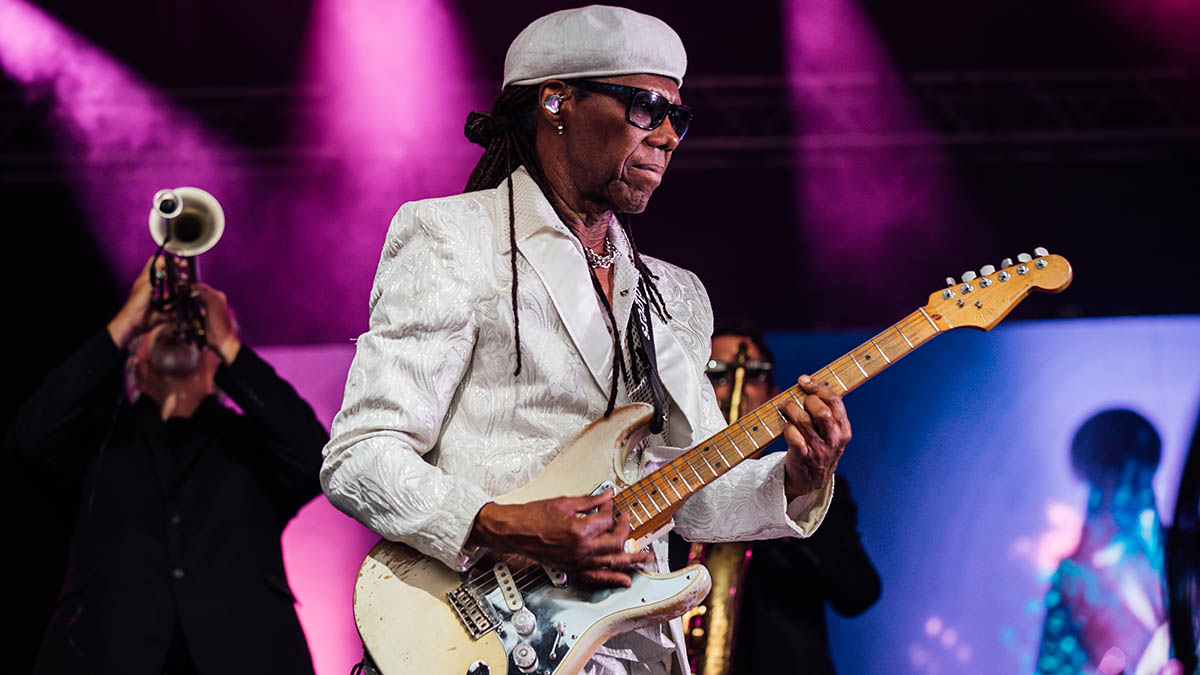Guitar strumming patterns: 5 ways to improve your rhythm playing
It's time to take your rhythm guitar chops to the woodshed with this lesson in the most fundamentally important technique in guitar

Strumming, indeed rhythm guitar as a whole, is a vital discipline that every guitarist should master. As much fun as it is to play blazing solos, the guitar is also an integral component in the rhythm section, and the ability to play chords fluently is a must. After all, in most styles, guitarists will spend the vast majority of their time focused on rhythm duties.
There are key styles that use strumming as a main facet, and certain players who do it paticularly well. Funk guitar is heavily reliant on 16th-note strumming, fusing chords with ghost notes and syncopation for a sophisticated and exciting sound.
It’s also an integral part of acoustic or folk guitar, forms the backbone of many a rock ballad, and is used as a ‘bed’ over which other instruments are laid when recording.
So strumming is both harmonically and percussively significant. Great rhythm players include Nile Rodgers, Jimmy Nolen (James Brown), Bruce Welch (Shadows), David Williams (Michael Jackson), Pete Townshend, Malcolm Young, and John Frusciante to name just a few.
There are a few things to consider when it comes to strumming. First off is what type of guitar pick to use, or whether to use one at all. Although a heaver pick (say 1mm or more) is perfect for accurate and articulate single-note picking, the ‘give’ in a lighter pick (say .060mm) lends itself better to strumming, as it makes things a little easier to play and adds a bright percussive ‘shimmer’ to the sound.
Other players choose not to use a plectrum at all, favouring the side of their thumb, or the backs of their fingernails. It is important to experiment with all options because you may find that different genres or styles favour different approaches.
Another thing to consider is the physical aspect of strumming. Good strummers tend to play from the wrist, keeping it nice and loose for a fluent and even attack. There is of course some movement from the elbow, but most of the movement comes from the wrist.
All the latest guitar news, interviews, lessons, reviews, deals and more, direct to your inbox!
Of course, every player has their own approach, so spend some time analysing your favourite artists or bands to see how they tackle their rhythm guitar technique.
There are four examples and a study piece for you this month, each focusing on a different musical style. Use them to try out different plectrums, or using no plectrum at all, and make sure that most of the action comes from your wrist and you’re not simply grinding your arm up and down.
Get the tone
Amp settings: Gain 3, Bass 4, Middle 5, Treble 6, Reverb 4
The above settings form the basis of the clean tones you’ll hear in the examples. When adding overdrive, make sure you don’t over saturate things, but allow the clarity of the notes to come through. Too much echo will confuse things, too, so use just enough reverb to make things sound sweet. And remember, an acoustic guitar will work for these pieces, too.
Examples in four different styles
Example 1
Our first example pays homage to Pete Townshend, a great rhythm guitarist. Of most importance is to keep the strumming hand moving in a consistent up and down motion. With this being a 16th-note pattern, the down beats - the ‘one’ and the ‘and’ should be on down strokes, while the ‘e’ and ‘a’ should be on upstrokes. This technique helps with fluency and timing, making it easier to lock in with the groove. Why not try this on acoustic?
Example 2
Here’s a funky one in the style of Nile Rodgers or Cory Wong. Approach this example exactly the same as Ex1. Keep your wrist loose and ensure an even up and down motion. There are some ghost notes here to add to the groove. To achieve these, lift your fretting hand slightly so that it is still in contact with the strings, but not pushing all the way down to the fretboard.
Example 3
This folky idea borrows from Bob Dylan and a little from Mumford & Sons. It’s based around a G Major chord but with moving bass notes. This style can be challenging at first because of the requirements to go from a precise single bass note to a strummed chord. Also, we’re in 6/8 time, so remember to think in threes or sixes, counting ‘1, 2 & 3 &, 4, 5 & 6 &’.
Example 4
This one’s much rockier and harks at players such as Malcolm Young from AC/DC, whose rhythm guitar playing is as solid as it is legendary. This example is different from the rest because it is played exclusively with down strokes. This approach is used to keep a consistent sound and attack for each chord. However, you can experiment with up strokes as well. The key thing is that you lock in with the bass and drums, and don’t push ahead.
Study piece
[Bars 1-8] Here you’ll encounter suspended chords and 16th-note strumming in a rock style, similar to that of Pete Townshend. It is important to use a combination of up and down strums and to keep the wrist loose to aid fluency.
The most challenging part is the quick hammer-on to the D/F# chord in bars 2 and 6. To help with this, I played the D/F# chord with my first finger barred at the 2nd fret, with the second finger on the third fret of the second string and the third finger on the 4th fret of the fourth string.
[Bars 9-17] This section is based around a repeating 16th-note strumming pattern with a series of ascending chords. Having the A Major chord with a C# in the bass (Major 3rd interval) aids the rising chord progression.
Again, keep your wrist loose and aim for even up and down strokes as notated on the score. As well as making sure the timing is strongly locked in, it’s also important to keep the dynamics even, the aim being not to have certain chords or strums louder than others.
Simon is a graduate of the UK's Academy of Contemporary Music and The Guitar Institute, and holds a Masters degree in music. He teaches, examines and plays everything from rock to jazz.

